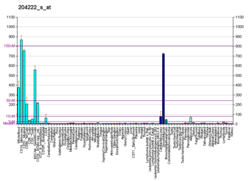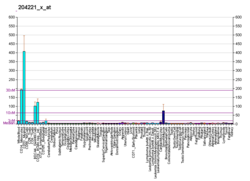
| GLIPR1 | |||||||||||||||||||||||||||||||||||||||||||||||||||
|---|---|---|---|---|---|---|---|---|---|---|---|---|---|---|---|---|---|---|---|---|---|---|---|---|---|---|---|---|---|---|---|---|---|---|---|---|---|---|---|---|---|---|---|---|---|---|---|---|---|---|---|
| |||||||||||||||||||||||||||||||||||||||||||||||||||
| Identifiers | |||||||||||||||||||||||||||||||||||||||||||||||||||
| Aliases | GLIPR1, CRISP7, GLIPR, RTVP1, GLI pathogenesis related 1 | ||||||||||||||||||||||||||||||||||||||||||||||||||
| External IDs | OMIM: 602692; MGI: 1920940; HomoloGene: 21357; GeneCards: GLIPR1; OMA:GLIPR1 - orthologs | ||||||||||||||||||||||||||||||||||||||||||||||||||
| |||||||||||||||||||||||||||||||||||||||||||||||||||
| |||||||||||||||||||||||||||||||||||||||||||||||||||
| |||||||||||||||||||||||||||||||||||||||||||||||||||
| |||||||||||||||||||||||||||||||||||||||||||||||||||
| Wikidata | |||||||||||||||||||||||||||||||||||||||||||||||||||
| |||||||||||||||||||||||||||||||||||||||||||||||||||
Glioma pathogenesis-related protein 1 is a protein that in humans is encoded by the GLIPR1 gene.
Function
This gene encodes a protein with similarity to both the pathogenesis-related protein (PR) superfamily and the cysteine-rich secretory protein (CRISP) family.
Discovery
The previous finding of RTVP1 (GLIPR1) as a p53 target gene with tumor suppressor functions prompted the researches to initiate a genome-wide sequence homology search for RTVP1/GLIPR1-like (GLIPR1L) genes. p53, the tumor suppressor gene is the most commonly mutated gene in human cancer. Mutation in p53 gene can lead to cellular malfunctions such as malignant growth and metastasis. Human GLIPR1, was initially identified in human glioblastoma and was called as GLIPR1 (glioma pathogenesis-related protein 1) or RTVP1 (related to testes-specific, vespid, and pathogenesis protein 1). Furthermore, it was identified as a marker of myelomocytic differentiation in macrophage. RTVP-1 cluster proteins share significant sequence homology with the members of (PR ) superfamily and CRISP Family proteins.
Structure
Protein structure: GLIPR1 is in two isomeric form, identifier: P48060-1 and P48060-2, which encodes 266(30,366 da) and 236( 26, 919 Da ) amino acid. The GLIPR1 proteins contains following domains:
• SCP: SCP-like extracellular protein domain •CAP: Cysteine-rich secretory protein family
These predicted transmembrane domains a makes them unique to mammalian CAP proteins and are not presented in any othert GLIPR1 isoforms. CAP domain is 15 KDa structurally conserved cystine rich domain as was historically referred to as SCP, NCBI cd00168 pr Pfam00188.
Gene location
GLIPR1L and Glipr1l genes are located very near RTVP1 within the range of 170 kb, in human it is in chromosome 12q21 and in chromosome 10D1 in mouse (Figs. 1A and 1B). In human GLIPR1 gene is located on the long (q) arm of chromosome 12 from base pair 71500001-75700000 (Build GRCh37/hg19)(map)
Gene expression
GlIPR1 is highly tissue specific with high mRNA, with the expression of GLIPR1L1 being with very high mRNA levels in testes but few traces in bladder followed by undetectable expression in prostate, kidney, lung, and bone marrow. The expression GLIPR1L2 was similar to GLIPR1L1.
Clinical significance
Study showed human GLIPR1 promoter to be highly methylated in prostate cancer tissues compared to the normal prostate tissue correlating with the decreased level of GLIPR1 expression. Hence, GLIPR1 has been proposed to act as a tumor suppressor that undergoes epigenetic inactivation in prostate cancer. This unique property of GLIPR1 might be effective for the control of malignancies. Preclinical studies has the significant suppression of tumor growth when AdGLIPR1 was directly injected into prostate cancer using an immunocompetent orthotopic mouse model.
Homology with plant defense mechanism
GLIPR1 exhibits 35% amino acid sequence identity with the tomato pathogenesis-related (PR) protein P14a, which has importance in plant defense mechanism. Comparison of these two protein lead to the identification of a common partially solvent-exposed spatial cluster of four amino acid residues, His-69, Glu-88, Glu-110, and His-127 in the GliPR numeration which indicates a common putative active site for GliPR and PR-1 proteins making a functional link between the human immune system and a plant defense system.
Cancer types/SNP positions
The graphical representation of number of positions affected by cancer type vs cancer type and number of cancer types vs postiiton in amino acid sequence is provided in the link.


References
- ^ GRCh38: Ensembl release 89: ENSG00000139278 – Ensembl, May 2017
- ^ GRCm38: Ensembl release 89: ENSMUSG00000056888 – Ensembl, May 2017
- "Human PubMed Reference:". National Center for Biotechnology Information, U.S. National Library of Medicine.
- "Mouse PubMed Reference:". National Center for Biotechnology Information, U.S. National Library of Medicine.
- Murphy EV, Zhang Y, Zhu W, Biggs J (June 1995). "The human glioma pathogenesis-related protein is structurally related to plant pathogenesis-related proteins and its gene is expressed specifically in brain tumors". Gene. 159 (1): 131–5. doi:10.1016/0378-1119(95)00061-A. PMID 7607567.
- Rich T, Chen P, Furman F, Huynh N, Israel MA (November 1996). "RTVP-1, a novel human gene with sequence similarity to genes of diverse species, is expressed in tumor cell lines of glial but not neuronal origin". Gene. 180 (1–2): 125–30. doi:10.1016/S0378-1119(96)00431-3. PMID 8973356.
- ^ "Entrez Gene: GLIPR1 GLI pathogenesis-related 1 (glioma)".
- ^ Ren C, Ren CH, Li L, Goltsov AA, Thompson TC (August 2006). "Identification and characterization of RTVP1/GLIPR1-like genes, a novel p53 target gene cluster". Genomics. 88 (2): 163–72. doi:10.1016/j.ygeno.2006.03.021. PMID 16714093.
- Hollstein M, Sidransky D, Vogelstein B, Harris CC (July 1991). "p53 mutations in human cancers". Science. 253 (5015): 49–53. Bibcode:1991Sci...253...49H. doi:10.1126/science.1905840. PMID 1905840. S2CID 38527914.
- Stapleton AM, Timme TL, Gousse AE, Li QF, Tobon AA, Kattan MW, Slawin KM, Wheeler TM, Scardino PT, Thompson TC (August 1997). "Primary human prostate cancer cells harboring p53 mutations are clonally expanded in metastases". Clinical Cancer Research. 3 (8): 1389–97. PMID 9815823.
- Thompson TC, Park SH, Timme TL, Ren C, Eastham JA, Donehower LA, Bradley A, Kadmon D, Yang G (March 1995). "Loss of p53 function leads to metastasis in ras+myc-initiated mouse prostate cancer". Oncogene. 10 (5): 869–79. PMID 7534899.
- Murphy EV, Zhang Y, Zhu W, Biggs J (June 1995). "The human glioma pathogenesis-related protein is structurally related to plant pathogenesis-related proteins and its gene is expressed specifically in brain tumors". Gene. 159 (1): 131–5. doi:10.1016/0378-1119(95)00061-a. PMID 7607567.
- Rich T, Chen P, Furman F, Huynh N, Israel MA (November 1996). "RTVP-1, a novel human gene with sequence similarity to genes of diverse species, is expressed in tumor cell lines of glial but not neuronal origin". Gene. 180 (1–2): 125–30. doi:10.1016/s0378-1119(96)00431-3. PMID 8973356.
- Gingras MC, Margolin JF (January 2000). "Differential expression of multiple unexpected genes during U937 cell and macrophage differentiation detected by suppressive subtractive hybridization". Experimental Hematology. 28 (1): 65–76. doi:10.1016/s0301-472x(99)00126-5. PMID 10658678.
- ^ Gibbs GM, Roelants K, O'Bryan MK (December 2008). "The CAP superfamily: cysteine-rich secretory proteins, antigen 5, and pathogenesis-related 1 proteins--roles in reproduction, cancer, and immune defense". Endocrine Reviews. 29 (7): 865–97. doi:10.1210/er.2008-0032. PMID 18824526.
- Asojo OA, Koski RA, Bonafé N (October 2011). "Structural studies of human glioma pathogenesis-related protein 1". Acta Crystallographica Section D. 67 (Pt 10): 847–55. doi:10.1107/S0907444911028198. PMC 3176621. PMID 21931216.
- National Center for Biotechnology Information, U.S. National Library of Medicine
- Ren C, Li L, Yang G, Timme TL, Goltsov A, Ren C, Ji X, Addai J, Luo H, Ittmann MM, Thompson TC (February 2004). "RTVP-1, a tumor suppressor inactivated by methylation in prostate cancer". Cancer Research. 64 (3): 969–76. doi:10.1158/0008-5472.can-03-2592. PMID 14871827.
- ^ Thompson TC (July 2010). "Glioma pathogenesis-related protein 1: tumor-suppressor activities and therapeutic potential". Yonsei Medical Journal. 51 (4): 479–83. doi:10.3349/ymj.2010.51.4.479. PMC 2880257. PMID 20499410.
- ^ Szyperski T, Fernández C, Mumenthaler C, Wüthrich K (March 1998). "Structure comparison of human glioma pathogenesis-related protein GliPR and the plant pathogenesis-related protein P14a indicates a functional link between the human immune system and a plant defense system". Proceedings of the National Academy of Sciences of the United States of America. 95 (5): 2262–6. Bibcode:1998PNAS...95.2262S. doi:10.1073/pnas.95.5.2262. PMC 19313. PMID 9482873.
Further reading
- Ren C, Li L, Goltsov AA, Timme TL, Tahir SA, Wang J, Garza L, Chinault AC, Thompson TC (May 2002). "mRTVP-1, a novel p53 target gene with proapoptotic activities". Molecular and Cellular Biology. 22 (10): 3345–57. doi:10.1128/MCB.22.10.3345-3357.2002. PMC 133782. PMID 11971968.
- Xiang C, Sarid R, Cazacu S, Finniss S, Lee HK, Ziv-Av A, Mikkelsen T, Brodie C (October 2007). "Cloning and characterization of human RTVP-1b, a novel splice variant of RTVP-1 in glioma cells". Biochemical and Biophysical Research Communications. 362 (3): 612–8. doi:10.1016/j.bbrc.2007.08.138. PMID 17825796.
- Chilukamarri L, Hancock AL, Malik S, Zabkiewicz J, Baker JA, Greenhough A, Dallosso AR, Huang TH, Royer-Pokora B, Brown KW, Malik K (November 2007). "Hypomethylation and aberrant expression of the glioma pathogenesis-related 1 gene in Wilms tumors". Neoplasia. 9 (11): 970–8. doi:10.1593/neo.07661. PMC 2077888. PMID 18030365.






